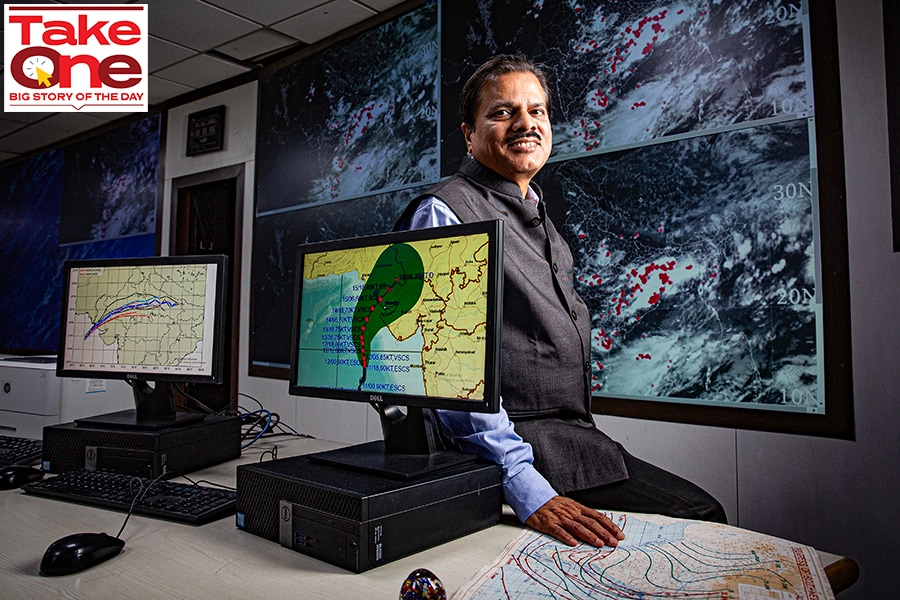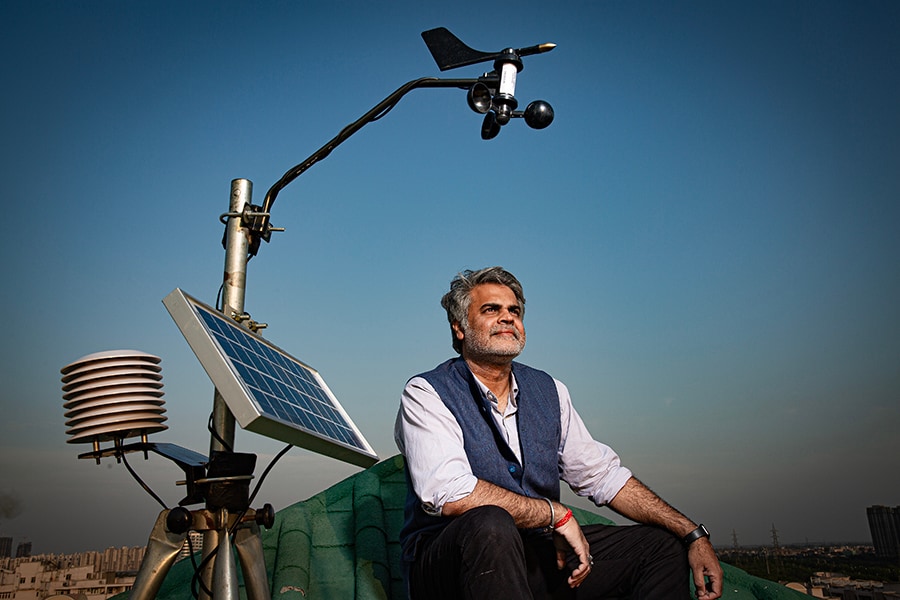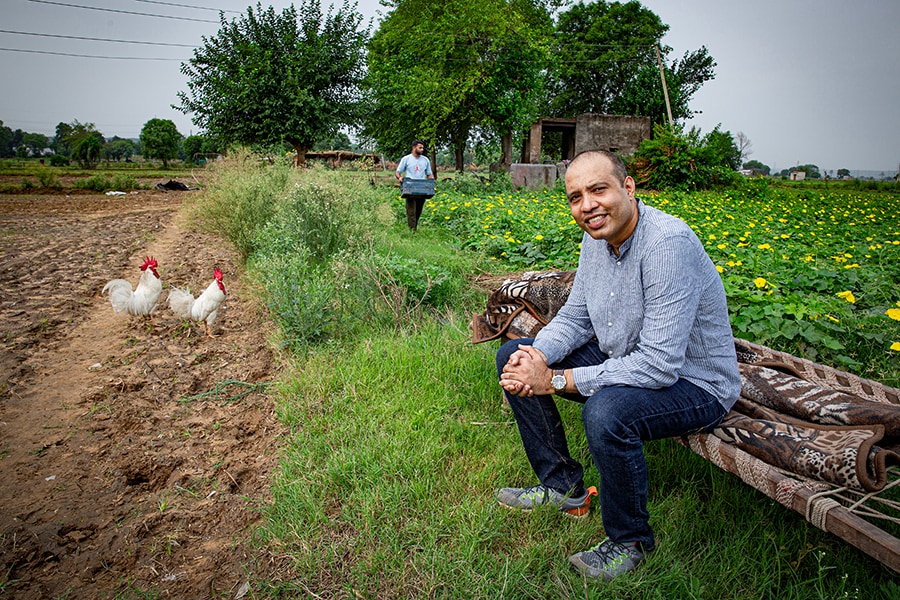
- Home
- UpFront
- Take One: Big story of the day
- AI will change the game for weather forecasts—but don't fire the weatherman just yet
AI will change the game for weather forecasts—but don't fire the weatherman just yet
Experts suggest that an extensive number of high-quality databases will be required to integrate artificial intelligence (AI) in weather forecasting, and it has the potential to transform the lives of farmers
 Mrutyunjay Mohapatra, director general of Meteorology, India, and India Meteorological Department (IMD); Image: Madhu Kapparath
Mrutyunjay Mohapatra, director general of Meteorology, India, and India Meteorological Department (IMD); Image: Madhu Kapparath
Do people who live at the same location need different weather forecasts?
Yes, actually.
The forecast that a paddy farmer needs, for instance, is different from that of a cotton farmer, or an industrialist, depending on the industry. In the age of hyperlocal and personalised experiences, and unpredictable weather patterns, what is perhaps one of the oldest services is in search of an upgrade.
Related stories
And as with most other industries, the new-age weatherman is turning to artificial intelligence (AI) for some answers.
“The expectations from the general public and from various stakeholders have increased manifold,” says Mrutyunjay Mohapatra, director general of Meteorology, India, and of the government’s IMD (India Meteorological Department). “They want more and more location-specific information, more accurate information and information that is catered to their very specific requirements.”
With the impact of climate change and the increase in severe weather events, weather forecasts are becoming crucial to industries including agriculture, textile, insurance, transport and healthcare. In India, the weather market was projected to reach $9.87 million in 2022, and show a CAGR of 15.72 percent from 2022-2027, reaching a projected market volume of $21.95 million by 2027, according to Statista.
While many industries that are seeing the benefits of AI are fairly new to handling big data, the weather industry isn’t; the IMD, for instance, has digital observational data that dates as far back as 1901, and satellite data from 1983.
Weather forecasting, experts say, is a multidisciplinary science. What AI definitely cannot do is replace physical observation models, nor numerical models.
“There’s a host of dynamical modelling that goes into weather forecasting,” says Jatin Singh, founder and director of Skymet, India’s largest private player in weather forecasting. “AI works best with set patterns; there is far too much variability in weather, and a dynamic cause and effect. What it can help in, however, is contextual analysis and better accuracy, as well as to develop other products.”
According to Mohapatra, the potential of the technology is huge, but for specific requirements. The IMD, then, has put together a group of scientists to work on incorporating AI in short-term forecasts (or ‘nowcasts’), and inked partnerships with the IIITs as well as with Google to accelerate the process.
Mohapatra says that the technology will help in:
1) Pre-processing and eliminating large chunks of irrelevant data that is used in numerical models
2) Better decision-making systems for various types of severe weather
3) Developing post-processed products that can cater to specific users; for example, a chat interface with personalised information on certain crops for farmers
4) Downscaling data, down to the panchayat or plot level
The group of scientists that the IMD has enrolled into the AI research group include those from AI/ML or computer science backgrounds, or those with an aptitude for the technology. It is too early yet to say when the products they are working on might be ready, and there is a flexibility in budgeting for the cause; however, Mohapatra says they have invested in computing systems and talent that will aid the programme.
 Jatin Singh, founder and director of Skymet; Image: Madhu Kapparath
Jatin Singh, founder and director of Skymet; Image: Madhu Kapparath
Meanwhile, Skymet has been using AI and ML algorithms for their crop identification product that uses remote sensing, and these models are currently being used by the government of India as well as banks that lend to farmers.
“With remote sensing satellite images, we are able to identify the crop, overlay the farmer as well as the crop on it, and provide details such as what crop the farmer is growing and what their turnover is. It can also help determine the acreage of the crop as well as the yield,” Singh says.
Soon, Skymet will launch a conversational product that uses Generative AI, which will allow farmers to talk to an AI assistant (currently available in Hindi, English and Marathi on the Skymet weather app) for custom weather insights for common queries and crops. This technology doesn’t work on probabilities but provides contextual analysis.
For predicting the weather itself, Skymet, like IMD, will use the technology to simplify its processes, but not replace its current models. For example, currently, it takes about 4 to 6 hours for the accumulation and processing of data for a typical forecast, considering the data is being collected in various forms and from various channels, including physical sensors. In that interim, much can change. So using artificial intelligence and machine learning, that computation time can be cut to allow for more accurate forecasts.
This is especially relevant now, as climate change is causing severe weather events around the year.
“India is a big country, surrounded on one side by the Himalayas, on the other by the Indian Ocean,” Mohapatra says. “We are seeing disasters and disturbances around the year—avalanches in the winter, cyclones in the summer, thunderstorms in the monsoon, and heat waves around the year. This has always been the case for India, but the frequency of extreme weather events has certainly increased.”
India, with its varied geography, comes with unique challenges, amplified by the fact that a lot of the forecast depends on accurate radar data, which is not always available from the remote parts of the country. An AI or ML model is only as good as the data that it has access to.
Another challenge is to disseminate the forecasts at scale, to those that need it the most for better decision making. Much of India’s agricultural sector, until quite recently, had limited access to smartphones or the internet, and Singh recalls a time when they would deploy agents to write out weather forecasts on boards at the gram panchayat level at certain villages. They have also partnered with TV channels.
“Now, as bandwidth has increased and with the Jio internet revolution, we have moved our focus to generating output in vernacular languages at a hyperlocal level. We have seen that smartphones have penetrated into the farmer community,” Singh says.

How AI can help the farmers
The agriculture sector is one of the most important industries in the Indian economy, contributing about 18 percent to India's GDP. Over 54 percent of the land in India is classified as arable with the agriculture industry comprising half of the labour market. The sector employs 151 million people, according to Statista.
However, the farmers have been battling extreme weather conditions. There is an uptick in climate-change induced shift in rainfall patterns and there is a rising frequency of crop-stirring heatwaves. Three of every four farms are at risk of crop damage from pests and weather. Crop yields are directly vulnerable to unfavourable weather conditions and natural occurrences like soil degradation, pest attacks, droughts and floods. The Indian Council of Agricultural Research (ICAR) predicts that climate change might lower yields by up to 9 percent over the course of the next 25 to 30 years. With AI, farmers will be able to make data-driven decisions in advance, yield healthier crops, control pests, and increase productivity overall.

Collection of the weather data will play a crucial role. As of now, IMD has a significant amount of data. But the number of weather stations overall are limited. The Centre is planning to set up weather stations under the Pradhan Mantri Fasal Bima Yojana (PMFBY), one each in every panchayat, with a five-year buy back guarantee of rainfall and temperature data to be generated from those units, as per reports by Hindu BusinessLine. There will be 1.75 lakh weather stations functional in the next two years without any capital expenditure, according to this proposed plan. The panchayat-level weather stations are expected to provide rainfall, temperature, humidity, wind and frost related data. A lot of granular data will be needed to make this plan successful and if it works out, it will be a game changer, especially for the farmers.
Weather patterns are becoming hard to decode. And at present, a handful of companies are dedicatedly working towards resolving this issue. Experts suggest if the data is made available, there will probably be hundreds of companies which can mushroom and build their solutions around it. India’s data science capabilities have proven to be useful in multiple sectors, weather could be another.
“Ideally, farmers should be getting weather updates almost on a daily basis, if not more frequently. So that is the importance and relevance of weather data when it comes to farming, almost everything depends on it,” says Hemendra Mathur, co-founder of ThinkAg, a platform for accelerating adoption of innovations in agriculture and food space. “Since I travel to the villages frequently, I keep asking the farmers if they get weather updates. The answer is mixed. In some progressive regions, they do get some updates from either private or public sector entities, but in most areas, they don’t even get an update.”
Just like Skymet’s Singh, Mathur too emphasised on having a robust dissemination network. “We need the framework for dissemination. Of course, one could be the free part of it, which is straightforward, but if there are some interesting insights, even the farmers would be willing to pay for it.”
Animal husbandry is another branch of agriculture where the application of AI in weather forecasting can help in taking timely action. Cattle and dairy is a large industry in India, it's almost $200 billion in consumption. There are about 200 million cows and 100 million buffaloes. Milk productivity is proportional to the temperature in some ways, explains Mathur. Apart from other factors like genetics and nutrition, temperature affects productivity a lot.
“If you look at the milk production data, typically summer months are lean months—April to July/August, with productivity going down significantly. We end up using lots of reconstituted milk, of course as a consumer we don’t realise but in winter, whatever is a surplus is converted into powder, and that powder gets converted into milk during summer months. That’s how it works. So for animal husbandry, any data point, which can guide farmers on what they need to be careful about, especially cattle health and hygiene, they will be able to predict a few things in advance.”
 Anuj Kumbhat, founder, Weather Risk Management Services (WRMS); Image: Madhu Kapparath
Anuj Kumbhat, founder, Weather Risk Management Services (WRMS); Image: Madhu Kapparath
Anuj Kumbhat’s startup Weather Risk Management Services (WRMS) is doing something on similar lines. After realising that India didn’t have enough infrastructure of weather stations to offer index insurance to farmers at a low basis risk, Kumbhat founded WRMS which is an agriculture and dairy risk management company. WRMS developed low-cost Automatic Weather Stations (AWS) to put up a network of weather data stations. They currently have 4,000 installed across India. The Gurugram-based startup was incubated by IIT Kanpur in 2004 with investments from Small Industries Development Bank of India (SIDBI) and IIT Kanpur.
Over time, WRMS saw demand from farmers for weather alert and forecast services which led them to develop weather forecasts for the next seven days. WRMS uses its ground station network to downscale and localise these forecasts thus making them more relevant and reliable for the farmers. They now have a complete agro-advisory solution with AI-based weather data cleaning and weather forecasting framework and also machine learning models for pest detection and pest propagation modelling.
They provide farmers with risk mitigation and risk transfer solutions and mostly work on the business to business to farmers (B2B2F) model.
Also Read- Agriculture 4.0 is a potential solution to meet food and climate goals
“Right now, we are testing a few models and evaluating the outcomes in smaller areas. Our specific objective of using AI is to improve our precipitation forecast. We are also developing AI models for better prediction of extreme events. In future, we plan to use AI for developing ensemble forecast systems for improving our weather forecasting capabilities,” says Kumbhat. AI is dependent on high quality data inputs. Hence, the extent of improvement would largely depend upon both quantity and the quality of the data inputs, he adds.

Need for strong database to make it work
To garner the benefits of AI in weather forecasting, high quality data will play a significant role. Bijal Brahmbhatt, executive director at Gujarat Mahila Housing SEWA Trust, agrees. Ahmedabad-based Mahila Housing Trust (MHT) is an autonomous not-for-profit organisation established in 1994 to empower women in poor communities across India to improve and upgrade their habitat. Through its grassroots programmes in habitat development and climate change resilience, MHT helps women to exercise their rights and uplift living conditions for their families and neighbours. They started working towards addressing climate change issues in 2015 and are currently in the process of integrating AI to predict weather.
The NGO is currently addressing heat, flooding, air pollution and water scarcity. They have started using weather forecasting for predicting heat, in collaboration with IMD and sending heat forecasts to the grassroots. MHT is present in 36 cities across India.
For incorporating AI, MHT has collaborated with CEPT University’s Center for Applied Geomatics (CAG). They will be advising and developing the AI model for MHT after the NGO collects and shares ground level data with them. Their agenda is also to understand the kind of gaps that come up during the data collection. “AI will help, but to what extent? We don’t know yet. A lot of people equate AI with different things. For instance, flood modelling was always happening for everything. Now that we are trying to develop AI for it, the big issue is that as it keeps developing certain things will, I'm sure, be eased out. But there will still be certain gaps and the world needs to know about it, otherwise there is this whole rigmarole behind AI. While the whole world is going gaga over it, we truthfully want to understand how it will help and what are the gaps that still need to be filled up,” says Brahmbhatt.
The NGO wants to ensure that the benefits of AI reach the micro level and smaller cities which are fast urbanising, where the negative impacts of climate change are not felt. To make the most of AI, MHT will also be using some ground level data which is being collected by the destitute women in different cities. The NGO has been training them since 2015.
“My understanding of AI is that the more data you feed into it, the better it gets, in terms of forecasting. So I think it will be a long-term initiative. But at least at the upfront, the stage is set,” concludes Brahmbhatt.







